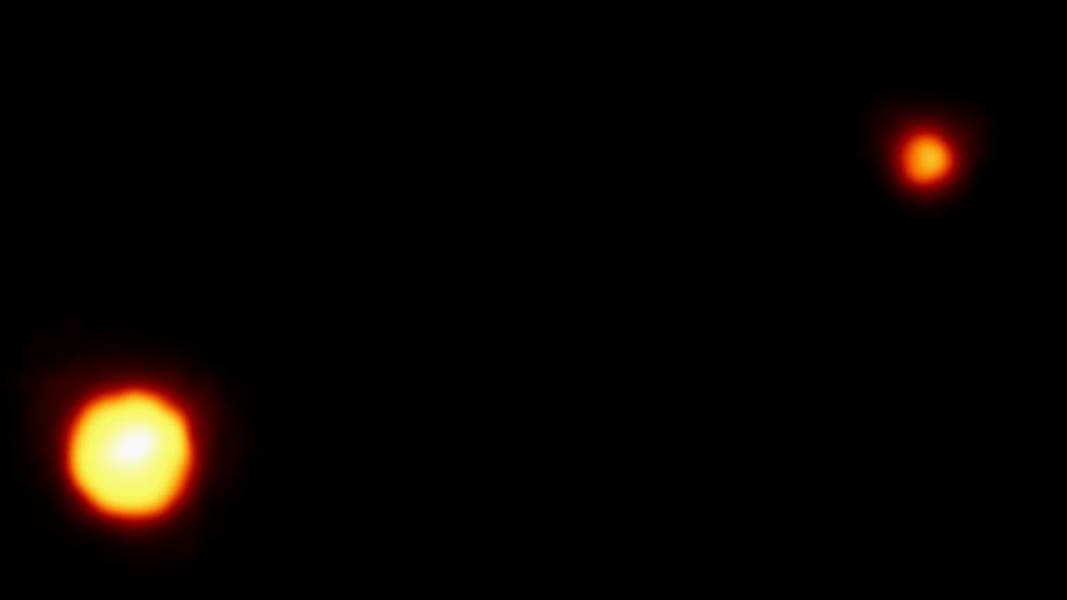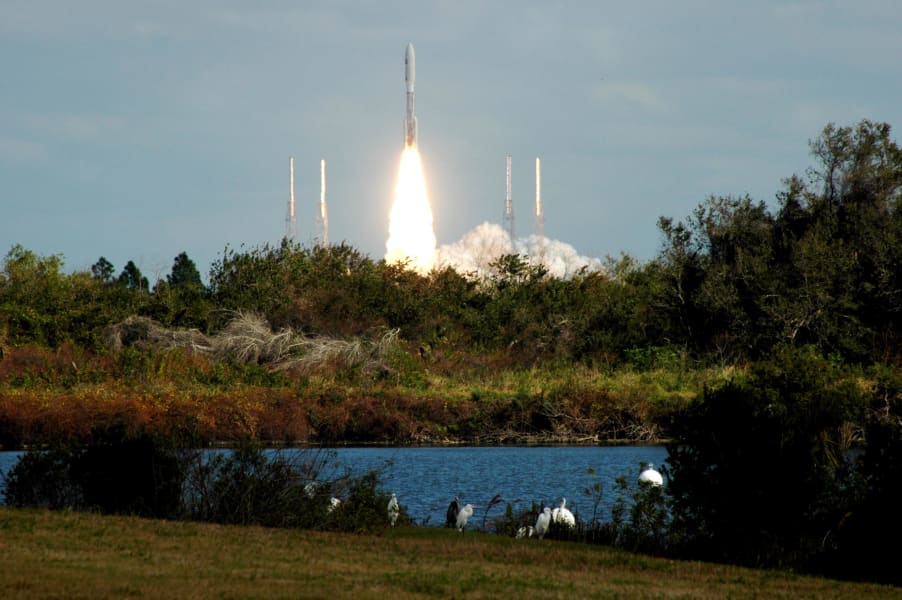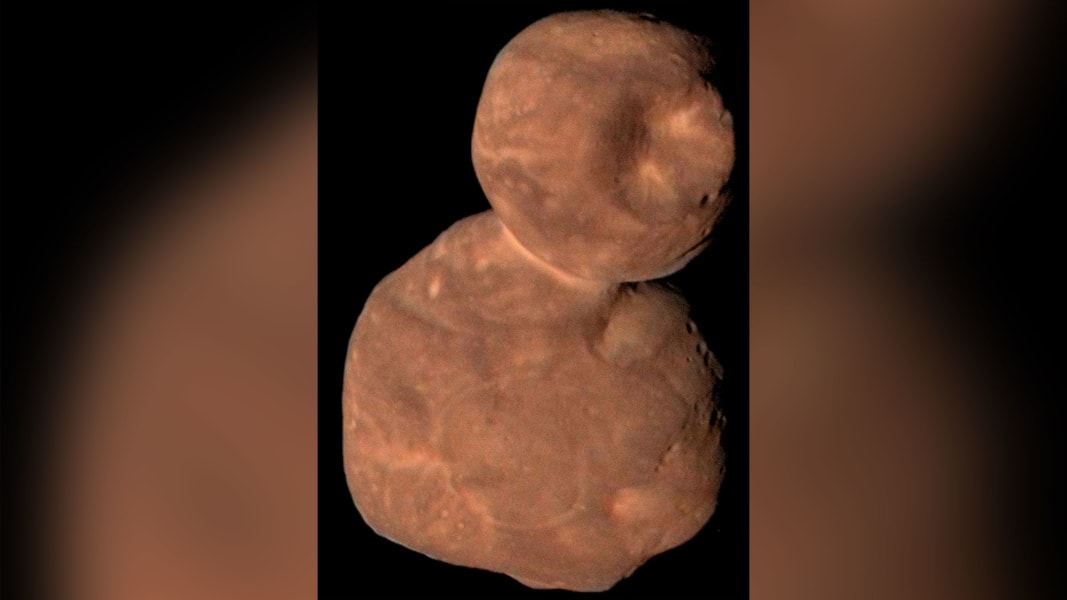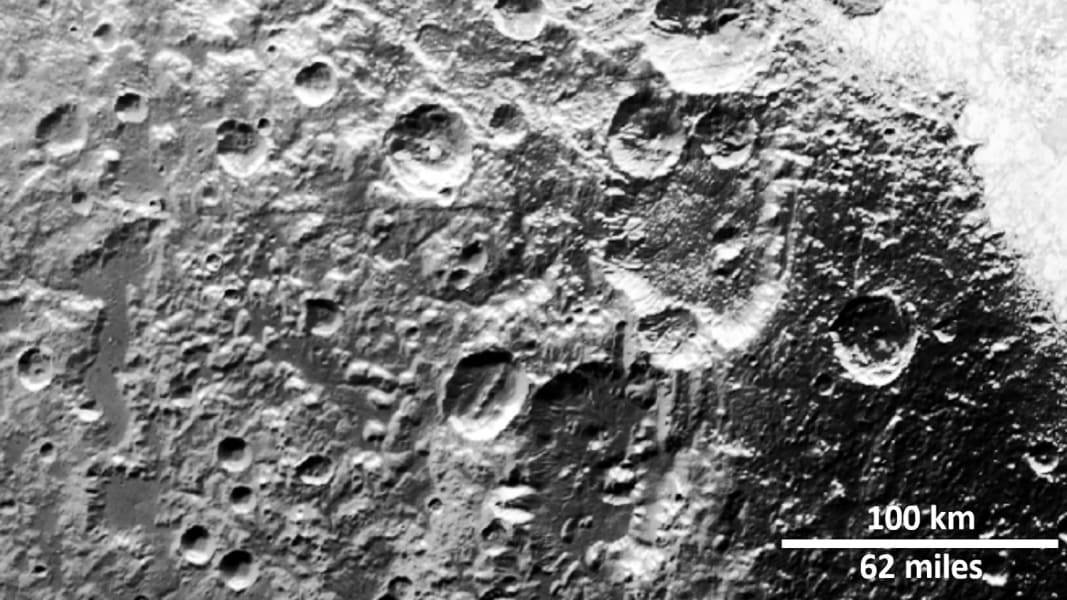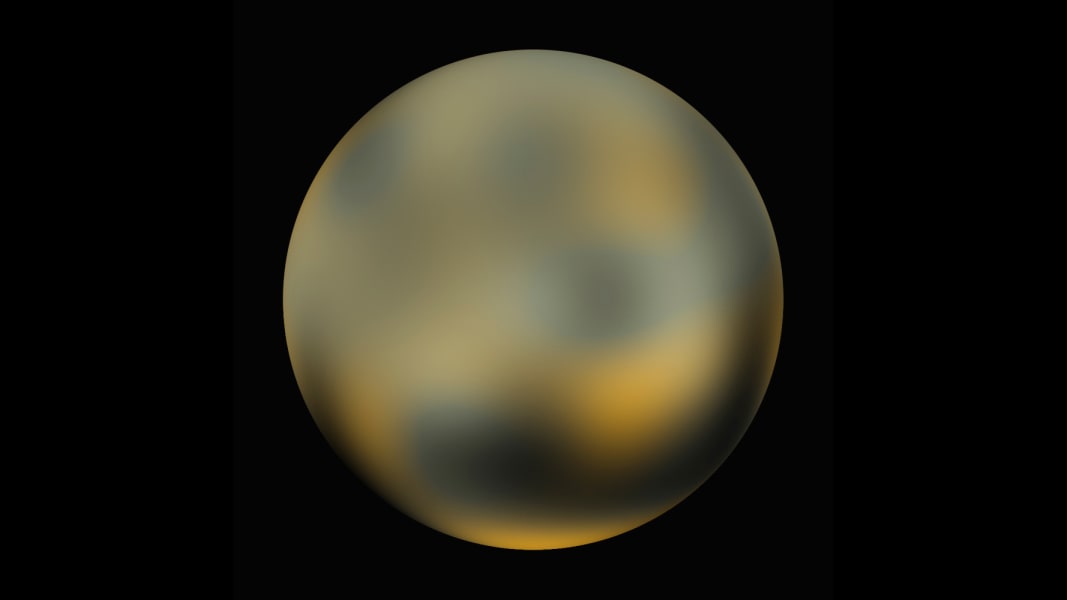Share
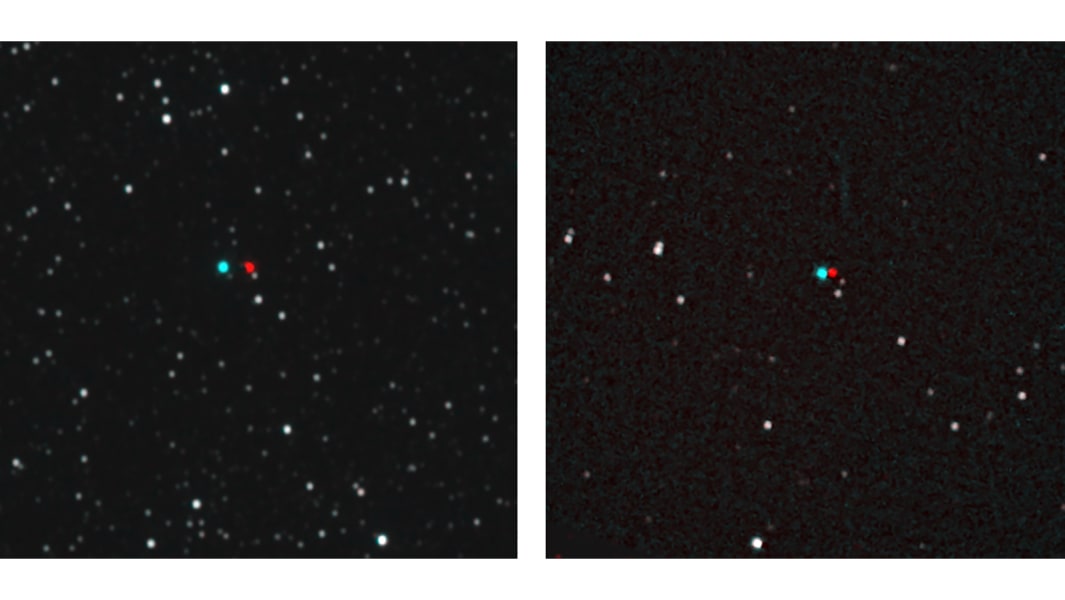

1 of 46
Have 3D glasses? You can view these stereo images that reveal the distance of the stars from their backgrounds, as seen by New Horizons. On the left is Proxima Centauri and on the right is Wolf 359. Tod Lauer/John Spencer/Brian May/NASA
The newly renamed object Arrokoth, once known as Ultima Thule, is ultrared, smooth and covered in organic complex molecules. New Horizons flew past the distant Kuiper Belt Object on January 1, 2019. NASA/Johns Hopkins University Applied Physics Laboratory/Southwest Research Institute/Roman Tkachenko
New Horizons images revealed that craters on Pluto and Charon were made by small Kuiper Belt objects. K. Singer/Southwest Research Institute/Johns Hopkins University Applied Physics Laboratory/NASA
When NASA's New Horizons spacecraft flew past Pluto in July 2015, it captured this image of the major mountain ranges where it meets a vast icy plain called Sputnik Planitia. The ridges in these photos have now been identified as dunes made of solid methane ice grains. NASA/JHUAPL/SwRI
New Horizons photographed what scientists are calling "bladed" terrain near the heart-shaped region of the dwarf planet. This 3-D image was created using two images taken about 14 minutes apart on July 14. The first image was snapped about 16,000 miles (25,000 kilometers) from Pluto and the second was taken when the spacecraft was 10,000 miles (about 17,000 kilometers) away. Break out your 3-D glasses for the best view. JHUAPL/SwRI/NASA
The New Horizons team has discovered a chain of exotic mountains that are covered in methane snow on Pluto. NASA released an image of the snow-capped mountains stretching across the dark expanse of Cthulhu on March 3. JHUAPL/SwRI/NASA
NASA released a photo on February 4, 2015, of what it suspects is an image of floating hills on Pluto's surface. The hills are made of water ice and are suspended above a sea of nitrogen. NASA/JHUAPL/SwRI
This image made in infrared light shows water ice is abundant on Pluto's surface. The image was created using two scans of Pluto made by the New Horizons spacecraft on July 14, when the probe was about 67,000 miles (108,000 kilometers) above Pluto. Johns Hopkins UniversityAPL/NASA
This image shows the layered interior walls of the planet's many craters. According to NASA, "layers in geology usually mean an important change in composition or event." However, NASA says the New Horizons team members do not know if they are seeing local, regional or global layering.
Most of the craters seen here lie within the 155-mile (250-kilometer)-wide Burney Basin. Learn more at NASA's website. NASA/JHUAPL/SwRI
Most of the craters seen here lie within the 155-mile (250-kilometer)-wide Burney Basin. Learn more at NASA's website. NASA/JHUAPL/SwRI
This image shows how erosion and faulting has sculpted Pluto's icy crust into rugged badlands. The prominent 1.2-mile-high cliff at the top is part of a great canyon system that stretches for hundreds of miles across Pluto's northern hemisphere, NASA says. Learn more at NASA.gov. NASA/JHUAPL/SwRI
Pluto's largest moon, Charon, in seen in enhanced color in this image taken by NASA's New Horizons spacecraft. The space probe took the image just before it made its closest approach on July 14. The image combines blue, red and infrared images to best highlight the moon's surface features. Charon is 754 miles (1,214 kilometers) across. The image was released on October 1. NASA/JHUAPL/SwRI
Images from two instruments on New Horizons are combined in this photo to show Charon's cratered uplands at the top and a series of canyons. The bottom of the image shows rolling plains. NASA/JHUAPL/SwRI
This composite of enhanced color images shows the striking differences between Pluto, lower right, and its largest moon, Charon. NASA says the color and brightness of the two worlds have been processed identically to allow for direct comparison. Pluto and Charon are shown with approximately correct relative sizes, but their true separation is not to scale. NASA/JHUAPL/SwRI
These photos show Pluto's variety of textures, including what NASA calls "rounded and bizarrely textured mountains." The mountains are informally called the Tartarus Dorsa. This image shows about 330 miles (530 kilometers) of Pluto's terrain. It combines blue, red and infrared images taken by the space probe's Ralph/Multispectral Visual Imaging Camera. The images were taken on July 14, during the probe's flyby. They were released on September 24. NASA/Johns Hopkins University/Southwest Research Institute
The photos taken by New Horizons just before its closest approach to Pluto on July 14 are the sharpest images to date of Pluto's varied terrain. This high-resolution image reveals details of two ice mountains. The image spans 75 miles (120 kilometers) of Pluto's surface. NASA/Johns Hopkins University Applied Physics Laboratory/Southwest Research Institute
This image of the surface of Pluto was taken just 15 minutes after NASA's New Horizon spacecraft made its closest approach to the icy planet on July 14. As it looked toward the Sun, the spacecraft's camera captured more than dozen thin layers of haze in Pluto's atmosphere, at least 60 miles (100 kilometers) above the surface. The photo was downlinked to Earth on September 13. NASA/Johns Hopkins University Applied Physics Laboratory/Southwest Research Institute
This image of Pluto's icy and mountainous landscapes was taken from a distance of 11,000 miles (17,700 kilometers). "This image really makes you feel you are there, at Pluto, surveying the landscape for yourself," said New Horizons Principal Investigator Alan Stern of the Southwest Research Institute in Colorado. NASA/Johns Hopkins University Applied Physics Laboratory/Southwest Research Institute
This picture is a synthesis of new high-resolution images downlinked from New Horizons. The broad icy plains have been nicknamed Sputnik Planum. This image is from a perspective above Pluto's equatorial area. Astronomers began downlinking a data dump from the space craft over Labor Day weekend, September 5 to 7. NASA/Johns Hopkins University Applied Physics Laboratory/Southwest Research Institute
Scientists say that what looks like mountains could be huge blocks of frozen water suspended in frozen nitrogen. On the new photos, taken on July 14 and released on September 10, a pixel is 400 meters (440 yards). New Horizons' closest pass by Pluto took it about 50,000 miles from the surface. NASA/Johns Hopkins University Applied Physics Laboratory/Southwest Research Institute
Pluto's landscape has lots of variety: plains, mountains, craters and what looks like they might be dunes. The smallest details on the photos are about half a mile wide. The area with the craters is ancient, scientist say. The smooth frozen planes are relatively young. NASA/Johns Hopkins University Applied Physics Laboratory/Southwest Research Institute
Just before its closest approach to Pluto on July 14, NASA's New Horizons spacecraft snapped this photo of Charon, Pluto's largest moon. The photo was shot at a distance of 290,000 miles away. Charon's north pole region is markedly dark. This photo was released on September 10. NASA/Johns Hopkins University Applied Physics Laboratory/Southwest Research Institute
This new image of Pluto is stunning planetary scientists. It shows the small world's atmosphere, backlit by the sun. NASA says the image reveals layers of haze that are several times higher than predicted. The photo was taken by the New Horizons spacecraft seven hours after its closest approach to Pluto on July 14. New Horizons was about 1.25 million miles from Pluto at the time. JHUAPL/SwRI/NASA
Images taken of Pluto's heart-shaped feature, informally named Tombaugh Regio, reveal a "vast, craterless plain that appears to be no more than 100 million years old," NASA said July 17. The frozen region "is possibly still being shaped by geologic processes." NASA's New Horizons spacecraft was launched in 2006 and traveled 3 billion miles to the dwarf planet. Johns Hopkins University Applied Physics LaboratoryNASA
Close-up images of a region near Pluto's equator revealed a giant surprise: a range of youthful mountains. NASA released the image on July 15. NASA
Remarkable new details of Pluto's largest moon, Charon, are revealed in this image released on July 15. NASA
The latest spectra analysis from New Horizons' Ralph instrument was released on July 15. It reveals an abundance of methane ice, but with striking differences from place to place across the frozen surface of Pluto. NASA
NASA team members and guests count down to the spacecraft's approach to Pluto on July 14. NASA
This image of Pluto was captured by New Horizons on July 13, about 16 hours before the moment of closest approach. The spacecraft was 476,000 miles from Pluto's surface. NASA
The colors in this image of Pluto and Charon are exaggerated to make it easy to see their different features. (These are not the actual colors of Pluto and Charon, and the two bodies aren't really that close together in space.) This image was created on July 13, one day before New Horizons was to make its closest approach to Pluto. NASA
This image of Pluto was captured by New Horizons on July 12. The spacecraft was 1.6 million miles from Pluto at the time. NASA
New Horizons snapped this photo of Charon on July 12. It reveals a system of chasms larger than the Grand Canyon. The spacecraft was 1.6 million miles away when the image was taken. NASA
New Horizons was about 3.7 million miles from Pluto and Charon when it took this image on July 8. NASA-JHUAPL-SWRI
Do you see a heart on Pluto? This image was taken on July 7 by New Horizons when it was about 5 million miles from the planet. Look to the lower right, and you'll see a large bright area -- about 1,200 miles across -- that resembles a heart. NASA-JHUAPL-SWRI
New Horizons took six black-and-white photos of Pluto and Charon between June 23 and 29. The images were combined with color data from another instrument on the space probe to create the images above. The spacecraft was 15 million miles away when it started the sequence and 11 million miles when the last photo was taken. Courtesy Nasa
Pluto is shown here along with Charon in images taken on June 25 and 27. The image on the right shows a series of evenly spaced dark spots near Pluto's equator. Scientists hope to solve the puzzle as New Horizons gets closer to Pluto. NASA
New Horizons took a series of 13 images of Charon circling Pluto over the span of 6½ days in April. As the images were being taken, the spacecraft moved from about 69 million miles from Pluto to 64 million miles. Johns Hopkins University/NASA
Look carefully at the images above: They mark the first time New Horizons has photographed Pluto's smallest and faintest moons, Kerberos and Styx. The images were taken from April 25 to May 1. Johns Hopkins University/NASA
New Horizons used its color imager to capture this image of Pluto and Charon on April 9. This was the first color image taken by a spacecraft approaching Pluto and Charon, according to NASA. The spacecraft was about 71 million miles away from Pluto when the photo was taken. Johns Hopkins University/NASA
In August 2014, New Horizons crossed the orbit of Neptune, the last planet it would pass on its journey to Pluto. New Horizons took this photo of Neptune and its large moon Triton when it was about 2.45 billion miles from the planet -- more than 26 times the distance between the Earth and our sun. NASA/Johns Hopkins University
New Horizons captured this image of Jupiter and its volcanic moon Io in early 2007. NASA/Johns Hopkins University
On its way to Pluto, New Horizons snapped these photos of Jupiter's four large "Galilean" moons. From left is Io, Europa, Ganymede and Callisto. NASA/Johns Hopkins University
A white arrow points to Pluto in this photo taken in September 2006 from New Horizons. The spacecraft was still about 2.6 billion miles from Pluto. NASA/Johns Hopkins University
Pluto was discovered in 1930 but was only a speck of light in the best telescopes on Earth until February 2010, when NASA released this photo. It was created by combining several images taken by the Hubble Space Telescope -- each only a few pixels wide -- through a technique called dithering. NASA says it took four years and 20 computers operating continuously to create the image. NASA/Hubble Space Telescope
This was one of the best views we had of Pluto and its moon Charon before the New Horizons mission. The image was taken by the European Space Agency's Faint Object Camera on the Hubble Space Telescope on February 21, 1994. Hubble Space Telescope/NASA/ESA
A Hubble Space Telescope image of Pluto and its moons. Charon is the largest moon close to Pluto. The other four bright dots are smaller moons discovered in 2005, 2011 and 2012: Nix, Hydra, Kerberos and Styx. NASA/Hubble Space Telescope
New Horizons launched from Florida's Kennedy Space Center on January 19, 2006. The probe, about the size of a piano, weighed nearly 1,054 pounds at launch. It has seven instruments on board to take images and sample Pluto's atmosphere. After it completes its five-month study of Pluto, the spacecraft will keep going deeper into the Kuiper Belt. NASA/KSC
